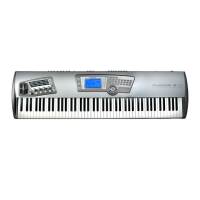ALESIS FUSION
ANALOG SYNTHESIS TUTORIAL
SOUND GENERATORS - WAVEFORMS
The oscillators....
The oscillators define the basic pitch and tone of an analog
synth sound. You can think of
them pretty much like the ‘strings’ of the instrument. They generate a basic waveform at
a pitch
set by a combination of tuning controls, the keyboard and different controllers.
Analogue synths typically offer five different waveforms. These are:
SAWTOOTH
A bright sounding waveform suitable for any number of
applications such as
strings, brass, pads, leadlines and more.
SQUARE
A hollow sounding waveform (not unlike a clarinet).
PULSE
A thin and reedy sounding waveform
2
TRIANGLE
A mellow sounding waveform (flute-like)
SINE A totally pure sound with no harmonics or overtones - the purest sound
known
to man.
The reason these waveforms all sound different is because they each contain
different
combinations
of ‘harmonics’ or ‘overtones’ which we will look at next. But before that, a brief
explanation of the nature of sound.
All sounds, to a greater or lesser degree, have
‘harmonics’ or ‘overtones’ and it is these
harmonics that define the tone or ‘timbre’ of a sound, the general rule of thumb being the more
harmonics, the brighter the sound (and
vice versa
).The predominant pitch we detect in a
musical note
is known as ‘the fundamental frequency’ and the harmonics are multiples of the
fundamental’s frequency.
Sawtooth wave
The sawtooth wave is very rich in both odd numbered and even numbered harmonics.
That is,
it has harmonics that are twice, three
times, four times, five times (and so on) the fundamental
frequency. Thus if the fundamental (and first harmonic) frequency is 500Hz,
the 2nd harmonic
is 1kHz, the 3rd is 1.5kHz, the 4th is
2khz, etc.. This creates a very bright sounding basic
waveform and is useful as the basis of many
different sounds including strings, brass,
leadlines, basses... in fact, almost anything! The sawtooth shape of the waveform
(which gives
it its name) is how the signal would look if seen on an oscilloscope. If
you looked at a trumpet’s
waveform on an oscilloscope, it would look similar.
2 On most synths, the ‘width’ or ‘symmetry’
of the pulse wave can be varied for a wider range of
tones. More later.
Sound generators
Page 4

